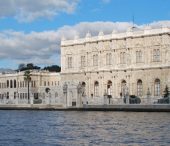Eskişehir is a city in northwest Turkey and the capital district of Eskişehir Province. According to 2000 census, population of the district is 519,602 of which 482,793 live in the city of Eskişehir. The city is located on the bank of Porsuk River, 792 m above sea level, where it overlooks the fertile Phrygian Valley. In the nearby hills one can find hot springs. The city is on the250 km (155 mi) west of Ankara, 350 km (217 mi) southeast of Istanbul and 90 km (56 mi) northeast of Kütahya. The province covers an area of 2,678 km² (1,034 sq mi).
History
The name Eskişehir means Old City in Turkish. Indeed the city was founded by the Phrygians about 1000 BC. Many Phrygian artifacts and sculptures can still be found in its Archeological Museum. There is also a museum of meerschaum stone, whose production remains still notable, used to make high quality meerschaum pipes. In the fourth century AD the city moved about ten km northeast, from Karadja Hissar to Shehir Euyuk.
Whenever it was mentioned by ancient geographers, the city was described as one of the most beautiful in Anatolia.
As with many towns in Anatolia, Christianity arrived after Constantine the Great made it the official religion of the Roman Empire. Beginning in the 4th century, records exist of bishops holding office in Eskişehir. The city was known as Dorylaeum, then. One of these bishops, Eusebius, was heavily involved in shaping the evolving dogma of the church.
Economy
Modern-day Eskişehir is one of Turkey's foremost industrial cities. Traditionally dependent on flour-milling and brickyards, the city expanded with the building of railway workshops in 1894 for work on the Berlin-Baghdad Railway. Eskişehir was also the site of Turkey's first aviation industry (Aeronautical Supply Maintenance Centre) and its air base is the headquarters of Turkey's First Tactical Air Force, on NATO's southern flank during the Cold War.
Eskişehir is one of the largest industrial centres of Turkey, with several modern industries, producing trucks, home appliances, railway locomotives, fighter aircraft engine, agricultural equipment, textiles, brick, cement, chemicals, processed meerschaum and refined sugar.
Attractions
Most of Eskişehir was rebuilt after the Turkish War of Independence (1919-1922). It is a well-functioning attractive place, but with few old attractions. One exception is the Kursunlu Camii Mosque. Near Eskişehir lies the site of the ancient Phrygian city of Dorylaeum. Eskişehir is noted for its hot sulphur springs.
Education
There are two universities in Eskişehir. These are Anadolu University and Eskişehir Osmangazi University. The current Metropolitan Mayor of Eskişehir Prof. Dr. Yılmaz Büyükerşen was formerly the rector of Anadolu University.
Culture
The city has a significant population of Crimean Tatars. It also attracted ethnic Turks emigrating from Bulgaria and Romania who contributed to the development of the city's metalworking industries.










